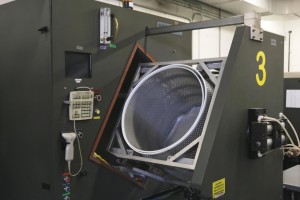Additional insight provided by Jordan Anderson of Nitrofreeze in Worcester, MA. Nitrofreeze offers both cryogenic and dry ice deflashing and deburring services.
Process: Automated and programmable batch process utilizing cryogenic temperatures, basket tumbling, and non-abrasive media. The cryogenic-grade polycarbonate media varies in size from a 0.004″ blend to 0.060.
Batch capacity: Batch processing available. Volume capability varies depending on part and machine size.
Anderson: “In our facility we have processed batches ranging from three parts to three hundred thousand parts. However, for 0.25″ to 2″ parts you’re usually seeing batches sizes around 1000 to 100 parts respectively. Cycle times can be around six to twelve minutes depending on the volume, material, tolerance, geometry of the parts, and machine size.”
Strengths: Non-abrasive; repeatable; reduced scrap and labor costs vs manual deflashing
Anderson: “A lot of customers we serve have strict cosmetic tolerances. Especially for surgical and aerospace parts, a change in surface finish is not allowable. Cryogenic deflashing yields a uniform clean without any of the gouging you can get from manual deflashing or the abrasion from other batch processes.”
Weaknesses: High integration and cost; After the initial equipment purchase, leasing or buying a nitrogen tank, and finally filling it with nitrogen, your initial costs can get steep pretty quickly. Like all batch processes, cryogenic deflashing struggles with parts where the residual flash thickness is similar to or greater than the thickness of the part.
Anderson: “It’s a great technology. It probably doesn’t make sense if you’re a small run or prototype molder. For low volume molders I’d look at a precision dry ice blaster.”


